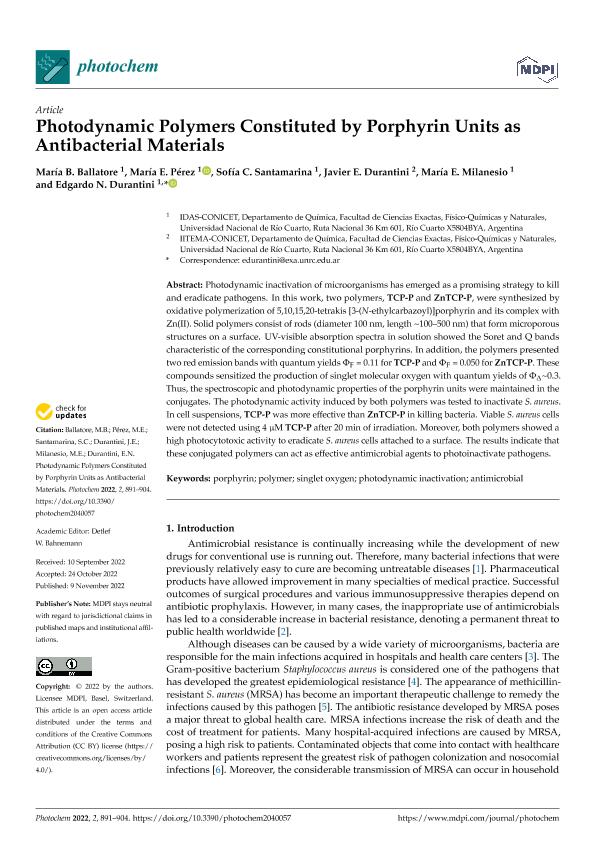Artículo
Photodynamic polymers constituted by porphyrin units as antibacterial materials
Ballatore, María Belén ; Pérez, María Eugenia
; Pérez, María Eugenia ; Santamarina, Sofia Carla
; Santamarina, Sofia Carla ; Durantini, Javier Esteban
; Durantini, Javier Esteban ; Milanesio, María Elisa
; Milanesio, María Elisa ; Durantini, Edgardo Néstor
; Durantini, Edgardo Néstor
 ; Pérez, María Eugenia
; Pérez, María Eugenia ; Santamarina, Sofia Carla
; Santamarina, Sofia Carla ; Durantini, Javier Esteban
; Durantini, Javier Esteban ; Milanesio, María Elisa
; Milanesio, María Elisa ; Durantini, Edgardo Néstor
; Durantini, Edgardo Néstor
Fecha de publicación:
11/2022
Editorial:
MDPI
Revista:
Photochem
ISSN:
2673-7256
Idioma:
Inglés
Tipo de recurso:
Artículo publicado
Clasificación temática:
Resumen
Photodynamic inactivation of microorganisms has emerged as a promising strategy to killand eradicate pathogens. In this work, two polymers, TCP-P and ZnTCP-P, were synthesized byoxidative polymerization of 5,10,15,20-tetrakis [3-(N-ethylcarbazoyl)]porphyrin and its complex withZn(II). Solid polymers consist of rods (diameter 100 nm, length ~100–500 nm) that form microporous structures on a surface. UV-visible absorption spectra in solution showed the Soret and Q bands characteristic of the corresponding constitutional porphyrins. In addition, the polymers presented two red emission bands with quantum yields 0.11 for TCP-P and 0.050 for ZnTCP-P. These compounds sensitized the production of singlet molecular oxygen with quantum yields of ~0.3. Thus, the spectroscopic and photodynamic properties of the porphyrin units were maintained in the conjugates. The photodynamic activity induced by both polymers was tested to inactivate S. aureus. In cell suspensions, TCP-P was more effective than ZnTCP-P in killing bacteria. Viable S. aureus cells were not detected using 4 microM TCP-P after 20 min of irradiation. Moreover, both polymers showed a high photocytotoxic activity to eradicate S. aureus cells attached to a surface. The results indicate that these conjugated polymers can act as effective antimicrobial agents to photoinactivate pathogens.
Palabras clave:
POLYMERS
,
PORPHYRINS
,
ANTIBACTERIAL
Archivos asociados
Licencia
Identificadores
Colecciones
Articulos (IDAS)
Articulos de INSTITUTO PARA EL DESARROLLO AGROINDUSTRIAL Y DE LA SALUD
Articulos de INSTITUTO PARA EL DESARROLLO AGROINDUSTRIAL Y DE LA SALUD
Citación
Ballatore, María Belén; Pérez, María Eugenia; Santamarina, Sofia Carla; Durantini, Javier Esteban; Milanesio, María Elisa; et al.; Photodynamic polymers constituted by porphyrin units as antibacterial materials; MDPI; Photochem; 2; 4; 11-2022; 891-904
Compartir
Altmétricas



